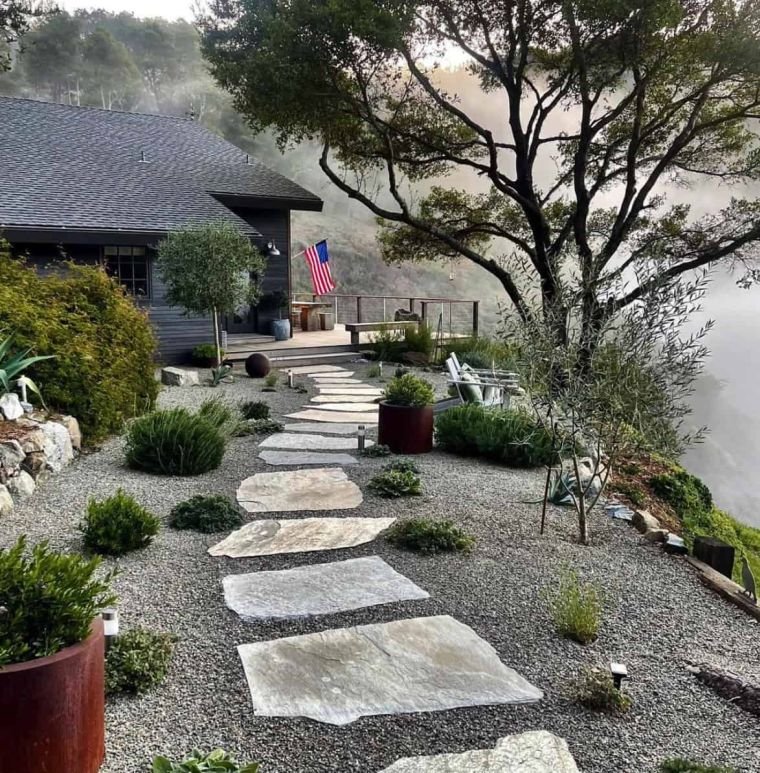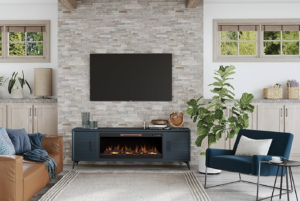
Have you ever wondered how to set up a contemporary dry garden? Creating a contemporary dry garden is easy to do, this type of garden is very beautiful and requires very little maintenance. It turns out that the contemporary dry garden is also very much in vogue at saving water through the use of gravel and drought-tolerant plants. The contemporary dry garden is a garden with self-draining soil that follows Mediterranean-type planting and is resistant to drought conditions. What is a contemporary dry garden? How to plan, fix and decorate it?
For your dry garden, you should choose green plants that are naturally found in dry areas to make sure these plants look good together. Generally speaking, dry garden planting tends to shorter-lived species, so it should be adopted. Have fun with annuals and succulents. As for the ecological benefits of the contemporary dry garden, these include saving water, fertilizers, less weeding and less mowing. The dry garden does not depend on rain or irrigation water and the plants found there are generally drought tolerant species.

Many of the drought-loving plants tend to be rich in nectar and are therefore of great benefit to a wide variety of insects. These gardens don’t really need fertilizers or chemicals to thrive. The contemporary dry garden is a garden that breathes. It is about drainage, giving the plants little opportunity to absorb water.

What is the contemporary dry garden? The contemporary dry garden is a garden that does not depend on rainwater or irrigation to thrive. Instead, green plants are chosen based on their tolerance to drought. How to plan the garden Contemporary Dry – When planning a contemporary dry garden design, it is very important to carefully evaluate the location you have available and choose the space that will be most appropriate there.

The first thing to do when planning your contemporary dry garden is to assess the space you have available. What is the annual precipitation? What type of soil do you have? How much sun does this space get? The answers to these questions help build an ideal plant palette. Try to work with what you have instead of making drastic changes to the site. Choose plants that are suited to these conditions. Observe where the light falls in the garden, as it can help you decide where to plant certain plants such as herbs, which are very beautiful when illuminated by sunlight.

How to choose plants for the contemporary dry garden
When designing and planning your dry garden, you should try to emphasize the contrasting shapes and textures, rather than thinking about the color of the flowers you are planting. You should try to emphasize the different characteristics of plants as your plants accentuate each other. The repetition of color, shape and form creates rhythm and guides the eyes through the design, giving the contemporary dry garden a sense of cohesion.

Start with the vertebrae of the bushes for a structure that can last year-round and only choose trees that don’t cast heavy shade. To create a little sweetness, plant ornamental herbs like Stipa gigantea and Stipa tenuissima. Soil-raising plants like thyme and Stachys byeantina can be woven between taller plants.

Think about the structure of your contemporary dry garden In your garden, opt for a mixture of species with a longer lifespan that will give structure and also for perennials with a shorter lifespan and annuals. Grow them without enriching the soil and water sparingly once the plants are established. Then let them develop freely.

If you plant the plants in deep gravel, be careful that the plant roots take root well into the soil below, experts advise. Try to choose the right green plant for the right location and plant at the right time of year to allow the plants to establish well, ideally in the fall or spring.

Make sure the location you choose is right for your contemporary dry garden. Sloped gardens should be terraced if you want to use gravel, and be wide open and sunny, although a little shade can go a long way to broadening the range of plants that can be grown in your area. Gravel gardens can be a hit in urban areas with an inevitable mix of sun and shade.

You need a small percentage of green plants that can tolerate sun and shade and repeat them throughout the pattern to properly ‘tie together’ the design. Try to work for the available space you have, not against it. The site must be draining, so avoid or enhance areas where water naturally settles, especially clay soils.

What are the best materials for the contemporary dry garden? A large amount of material must be introduced into the soil for planting: gravel, sand, crushed hard core, or concrete – in fact, anything that improves drainage, experts suggest. Next, a graded gravel mulch is needed to prevent unwanted vegetation germination and to provide space.

Cultivate a local stone or gravel for a mulch that works well in terms of integration with the local environment and is good at reducing your carbon footprint with transportation. You can stick to durable natural materials, textured stone, rock, gravel, and hardwoods without a problem.

Get inspired by nature for the layout of your dry garden. In some areas of the garden you may well let the dynamic evolution of the natural landscape reign. Rather than trying to create a fixed landscape, let the ground cover evolve from year to year in a pattern that is governed by soil, climate, and the planting itself. Taking inspiration from nature, it is possible to adapt your approach to preserving garden surfaces and opt for a ground cover garden that is well suited to local conditions and easy to maintain.

Choose gravel in your dry garden
Poor, rocky soil is a boon for gardens where you want to grow a wide variety of ground cover plants that require very little maintenance. Herbs grow more easily in poor soils than in rich soils, and ground cover plants can spread more comfortably without the risk of being overwhelmed by competitors. A gravel garden is a good option to almost completely suppress the germination of herbs. This balance between plants and stone is very characteristic of Mediterranean landscapes.

Think about the amount of grass that is absolutely necessary in your garden and especially in the front garden. And then try to remove the grass from places where its presence really cannot be justified. Why should a contemporary garden of the 21st century follow the aesthetics developed during the 18th century?

Lawns are so ubiquitous today that they risk making our gardens too simple and drab. Finding ways to replace your lawn with something else is a big decision against uniformity, experts advise. When not an aesthetic choice, the need for a step surface in the garden is often used to justify that a large area of grass required for matche passage is generally greatly underestimated.

Choose ground cover plants
Replacing lawns in the garden allows you to regain the surface, but what can you put in its place? You can think of not just one alternative to lawn, but several to allow for multiple ground cover solutions to suit the needs of each garden area. Green plants that form a true green carpet are suitable for walkways where you can walk very well. In areas where there is no real step, you can create garden beds for perennials and shrubs whose dense foliage prevents light from reaching the ground and therefore limits plant competition.

Make Your Small Dry Garden Visually Expand By Choosing Layers
Not all dry gardens need to be completely dry. A good mix of green plants, including those with significantly reduced water consumption and others that are a little more thirsty, can be a very nice thing to do. But how do you create a layered garden in an existing garden? When looking to add layers to your existing garden, avoid species that need a lot of water to survive and opt for plants native to your area or plants that tolerate drought.

We hope this information will help everyone who wants to make a suburban area look beautiful, unusual and modern. Do not forget that you need to think about the landscape design down to the smallest detail. Ponds are often used for zoning territories, as well as to effectively emphasize the central part of the garden. The most interesting thing is that the presence of water for a dry garden is completely optional. We will tell you about such an interesting design element as a dry stream. This idea has many advantages.

In addition to its visual appeal, a dry stream performs several useful functions: it serves as a natural disguise for engineering communications, while maintaining easy access to them; It is a good choice to decorate the height difference on the site (the stone stream that falls from the hill looks very beautiful, and if you decorate it with flowers and shrubs, you can create a real masterpiece that feasts the eye every day ); It can serve as a drainage system to drain the water.

Like any other element of landscape design, the design of a dry stream needs careful thought. You need to create a drawing on which you can sketch the design, make a list of materials and ornamental plants. If you are inexperienced with such calculations, then the task may seem very difficult. However, it is quite real, just show patience and imagination.

The main advantage of this unusual garden is its versatility

A dry garden can be created anywhere

Regardless of the landscape design style you can create a dry garden

Virtually maintenance-free and looks good at any time of the year





